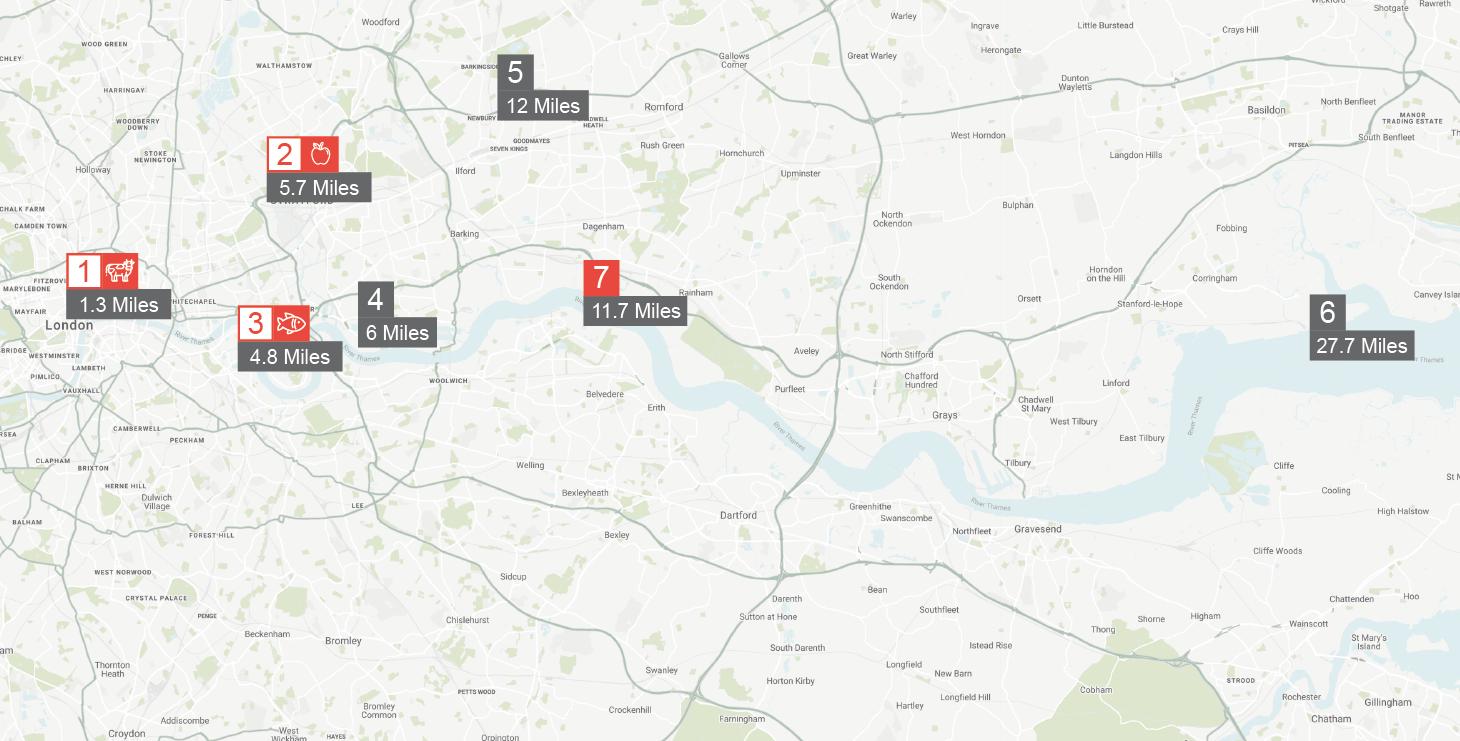The site
Map showing the current markets and the sites assessed during the site search process. Distances are measured from central London (Charing Cross).
Google Map data ©2020

Map Key
Existing sites:
1. Smithfield Market
The Grade II* listed buildings means there are limitations on the modifications that can be made to improve trading conditions and enhance the efficiency of the market.
One of the biggest challenges for Smithfield Market comes from being an open environment and the ongoing risk of mixing HGV’s forklift trucks, market workers, pedestrians, cars and cyclists.
The risk between market operations and the public is expected to become even more challenging with the opening of the Elizabeth line and the Museum of London’s relocation to West Smithfield.
2. New Spitalfields Market
The UK’s largest wholesale fruit and vegetable market was built in the early 1990s, but some parts of the building are already outdated and there is not enough room for tenants to store and display their produce.
The restrictive site design, which has no unloading bays or delivery docks, creates substantial operating challenges, including safety issues between pedestrians and forklift truck drivers, which drive through the main market floor.
In the new market, sufficient space and better facilities for deliveries and collections can be integrated into the building, alleviating some of the current logistical challenges.
In the current location, the market cannot expand as the adjacent land is Metropolitan Open Land.
3. Billingsgate Market
The UK’s largest inland fish market faces some of the biggest challenges given the stringent safety standards for handling fish.
A new facility would provide a temperature controlled environment.
In the new market, sufficient space and better facilities for deliveries and collections can be integrated into the building, alleviating some of the current logistical challenges.
Currently, tenants rely on ice to keep their produce chilled on display in order to meet their customers’ expectations for fresh fish and to reduce the volume of food waste.
Assessed options:
4. Silvertown, LB Newham
Although the site was the closest to the existing markets, the relatively small acreage (around 19 acres) meant the market hall would be spread vertically over a number of levels, which is something that the tenants did not want.
5. Fairlop, LB Redbridge
The site in Fairlop offered a good balance between the size and proximity to London. However, the land was designated as green belt, and had little potential to embrace more sustainable transport solutions.
6. Thames Enterprise Park, Thurrock
The site in the Thames Enterprise Park was large, at well over 100 acres, and was accessible by rail or river at the nearby Thames Gateway Port.
However, its distance from central London was a concern for tenants.
Selected option:
7. Dagenham Dock, LB Barking and Dagenham
This site was the former Barking Reach Power Station and was acquired by the City of London Corporation in December 2018. With 42 acres of industrial land, connections to the rail network and the River Thames, the site had a number of advantages.
After a wide-ranging search and thorough assessment of other sites, Dagenham Dock was identified as the preferred site to co-locate the markets.
This site was the former Barking Reach Power Station, which was constructed between 1992 and 1995 and closed in 2014.
It is located at Chequers Lane in Dagenham, to the west of Dagenham Breach and south of the A13. With 42 acres of industrial land, connections to the rail network and the River Thames, the site has a number of advantages.
The location benefits from a direct link to the A13 road network as well as good rail and bus links. Access to the River Thames also presents a significant opportunity to use the river for the movement of goods.
Progress so far
• Nine electrical pylons decommissioned
• Turbine hall, cooling towers and warehouses demolished with only the cooling water head shaft remaining on site
• Ground investigation concluded and site remediation strategy agreed with the Environment Agency
• Stakeholder consultation underway for off-site asset decommissioning (gas pipeline and water-cooling tunnels)

